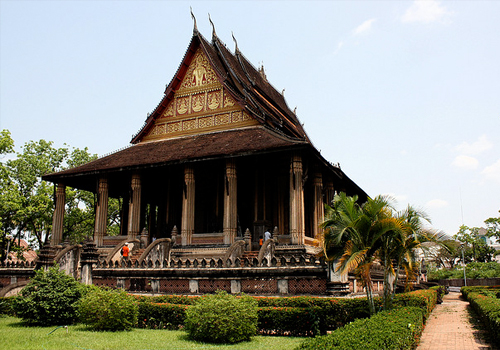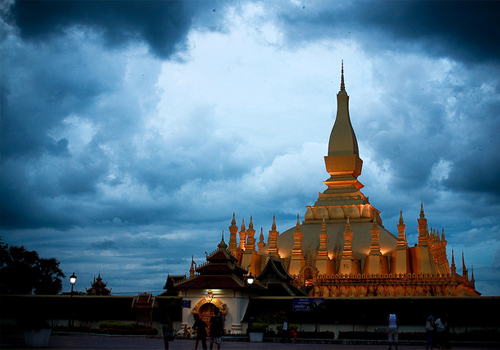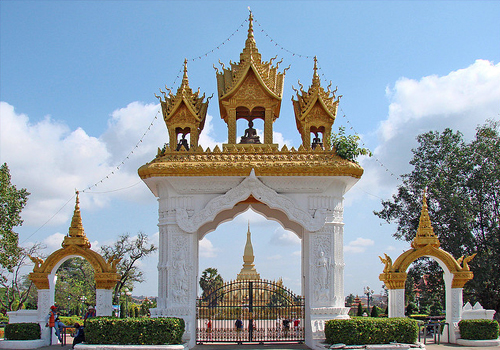Vientiane Travel Guide
That Luang (Royal Stupa)
Address: That Luang Village, Xaysettha District, Vientiane Vientiane
Admission: LAK 5,000 Tuesday - Sunday: 8am to 12pm; 1pm to 4pm. Closed on Mondays.
Telephone: +856 21 454984
The Royal Stupa is a symbol of Buddhism and Lao rule, and is Laos' most important religious building. A wonderful sight for tourists in Vientiane to behold, the dazzling golden temple and its spire are visible from afar. Locals claim that if you have not visited That Luang, you have not visited Laos. The base of the stupa has walkways and stairs connecting the different levels, designed for the faithful to climb. Each level has different architectural features pertaining to Buddhist doctrine. Worshippers stick balls of sticky rice to the walls as a mark of respect to the spirit of King Setthathirat, who built the shrine in 1566 and whose statue stands in front of the temple. The effects of the setting sun on its golden surface are stunning. There is a lot to see in the area and it is best to have a local guide to explain the significance of the site. Paying entrance only allows access to the base around the stupa. The view from the other side of the walls, however, is just as good and many prefer not to pay. The three temples that surround it are free and the golden, reclining Buddha statue does not require an entrance fee, either. It is best to get to the site early, before the tour buses arrive.<br /><br />
Xieng Khuan (Buddha Park)
Address: Thanon Tha Deua, Vientiane, Laos Vientiane
Admission: 8am to 6pm
The site known as Buddha Park is a bizarre collection of Buddhist and Hindu statues scattered around a riverside meadow, dominated by a gigantic reclining Buddha. Hundreds of huge concrete structures that combine Buddhist and Hindu philosophies are spread around representing a variety of deity forms. Fashioned by a purported holy man, the sculpture park was created to spread his beliefs and to reveal to mankind his ideas about the universe. This odd attraction is popular and has many unexpected treasures. There is amazing detail on many of the statues, which are not the run-of-the-mill kind seen all over Laos but in many cases are quite unique. There is fun to be had climbing and exploring: don't miss the giant pumpkin-like statue which one enters through the gaping mouth and ascends via steep internal steps to reach a viewing platform and a beautiful Tree of Life sculpture on the top. The park is a pretty area and visitors are free to touch, take photos and explore without much restriction which is refreshing. There is a restaurant at the park which serves decent food. Getting there takes a while but the rural scenery that is passed along the way makes the journey interesting in itself.<br /><br />
Si Phan Don
Address: Vientiane
The famous 4,000 Islands region of Laos unfolds at the tail of the Mekong River in the far south of the country, lapping over into Cambodia. The area is renowned for its spectacular waterfalls, tranquil village life and unspoiled natural beauty. It is also home to the rare and only occasionally sighted pink Irrawaddy dolphin. The two most popular islands are Don Khong, the largest and most developed, and backpacker-magnet Don Det. Prices for accommodation and food are some of the cheapest in Asia. The area is also used as an entrance point to Cambodia, and buses frequently make the one-hour journey to the border. Don Det has become a bit grubby of late, although some people still rave about it. Don Khong seldom gets a bad review. This is the place to spend slow days hiking, biking, kayaking, swimming and relaxing in bungalows with balconies over the water. There is lots to see and do, including heading out for water safaris to look for the dolphins - be sure to ask the guides not to go too far, or else be prepared to pay a border crossing fee, as Cambodia is literally a stone's throw away. Si Phan Don is an unmissable place to visit in Laos for young travellers, or those travelling on a tight budget.<br /><br />
Victory Gate (Patuxai)
Address: Vientiane
Modelled to mirror the Arc de Triomphe in Paris, Laos' Victory Gate is definitely a sight to behold. Although it is said to be a replica of Paris' Arc de Triomphe, the Laotians decided to one-up their colonial masters by building theirs slightly higher and with four gates (instead of the two that the European version has). Patuxai also has a number of decorative Buddhist ornamentations added to the original design. Apparently the structure was never quite completed and the locals like to joke about the fact that it was supposedly built from cement donated by the US and intended for an airport - which makes the 'victory' a little less defiant but perhaps more snide. To the casual observer it seems perfectly finished. The monument is open to those wishing to brave the heat and climb the seven flights of stairs, which, once surmounted, offer great views of downtown Vientiane. There are souvenir shops in between flights of steps but these are quite expensive. In the same area visitors can see the World Peace Gong presented to Laos by Indonesia, as well as a musical fountain. The landmark has become a gathering point for locals and some great photos can be taken of the structure.<br /><br />
COPE Visitors Centre
Address: Ku Weing Road Vientiane
The COPE Visitors Centre can be a sobering reality-check for many visitors to Laos, but nonetheless is definitely worth a visit. Statistically, Laos is the most bombed country in the world, as a result of the US policy of letting planes offload their unused ordnance onto Laos during the Vietnam War (it was deemed unsafe for them to land with a cargo of unused bombs so they simply dropped them on Laos). This is an embarrassing and tragic aspect of the Vietnam War which many are totally unaware of. Laos has a significant amount of UXOs, or unexploded ordnance, particularly in rural areas along the border with Vietnam. Many residents of Laos have been victims of UXOs and the COPE Visitors Centre does vital work in educating the public and tourists and providing help for those who have lost limbs or loved ones to bombs. The Visitors Centre includes a gift shop and a selection of short films on Laos and UXOs. You may have to request to see the films but the staff are helpful and knowledgeable and will gladly assist you.<br /><br /> The centre is not far out of town and many visitors like to hire bikes and cycle out to it. You will only need an hour or so to explore the place but it exposes tourists to a vital aspect of life in Laos and shouldn't be missed. Moreover, if you are planning to travel off the beaten track in Laos, knowing how to recognise and react to UXOs is important.<br /><br />
Houey Hong Vocational Training Center for Women
Address: Lane 19, Houey Hong Village, Chantabury District, Vientiane Vientiane
Admission: Monday through Saturday: 08.30am - 12.00pm, 1.30pm - 16.30pm
Telephone: +856 (0)21 560006
One of Laos' most popular activities for tourists in recent years is a trip to the wonderful Houey Hong Vocational Training Center for Women. The centre's mission is to provide education and training to Lao women from disadvantaged backgrounds, to help assimilate them into the contemporary economy by teaching them the skills of natural dyeing, traditional Lao weaving, tailoring and small business administration. The centre is thus an important contributor to the Laos government's initiative of sustainable development in the local craft and tourism sectors of the economy. Visitors to the Houey Hong Centre are not just casual observers: rather, they partake in half- or full-day courses of their choice, in which they too are taught skills ranging from tie-dyeing silks to traditional Lao weaving using a loom. The Houey Hong Centre is a short tuk-tuk ride from downtown Vientiane and provides tourists to Laos with an unforgettable experience of traditional textile manufacturing, not to mention the chance to contribute sustainably to the upliftment of the local population. The best part? You get to keep whatever you make during your time at the centre to show off to your friends back home. These crafts make the most appealing souvenirs.<br /><br />
Ho Phra Kaew
Address: Rue Setthathirath, Vientiane Vientiane
Admission: Daily: 8am to 12pm; 1pm to 4pm.
One of Vientiane's oldest and most grandiose temples, Ho Phra Kaew has an extremely interesting history that sheds light on Laos' past relations with Thailand. The temple was built in 1565 by King Setthathirat for the express purpose of housing the Emerald Buddha, which he had pilfered from Chiang Mai in Thailand. The statue, made of green jadeite enrobed in gold, was then recaptured by the Siamese army in 1778 and returned to Bangkok (where it remains to this day). Even without the Emerald Buddha, Ho Phra Kaew - which was restored in 1936 and declared a national monument - is a wonderful tourist attraction, offering visitors to Vientiane a great opportunity to get to grips with Laos' varied cultural heritage. Among the items on display in the museum is a heavily-lacquered 16th-century door carved with Hindu images, and a collection of stone-cut figures representing Khmer deities. Note that although the temple houses some interesting artefacts the labels explaining their origins are only in French and Lao so it is worth doing some research beforehand if you don't speak these languages.<br /><br /> The temple is near the town centre and has a lovely garden. Photographs are permitted. There is a small entry fee.<br /><br />
Talat Sao (Morning Market)
Address: Talat Sao Mall, Lane Xang Avenue, Vientiane Vientiane
Admission: Monday to Friday: 7am to 6pm (some stalls may close earlier).
Telephone: +856 21 285 001
Sometimes while travelling it's nice to take a break from visiting the usual tourist attractions and to experience the country as the locals do. Vientiane's Talat Sao (Morning Market) offers visitors the chance to do just this, with a bustling market-place that, despite its name, is open from 7am to 6pm every day. A wonderful place to do most of your holiday shopping in Laos, the Morning Market is housed over four floors in two Lao-style buildings, whose construction was largely paid for by the market vendors themselves. Although the market mainly caters to the local population (one can buy electric rice cookers and have shoes re-soled here), there are still plenty of authentic Lao products for tourists to snap up for a bargain. Be on the lookout for hand-woven fabrics, silver jewellery and local handicrafts. Bargaining is expected and generally very good-natured so be sure to smile, but don't be shy to beat down a price. There are also food stalls located right outside the buildings, allowing visitors to refuel between shopping expeditions. For those familiar with the sprawling markets of places like Thailand and Malaysia, this one may seem small and unimpressive, but for the uninitiated it is exciting.<br /><br />
Lao New Year
Where: ,Vientiane
When: 14 - 16 April 2018
Lao New Year is known as Bpee Mai or Songkran and it's the biggest and most exuberant celebration of the year for both Laotian people and tourists to Laos, who invariably get roped into the festivities. New Year takes place on the cusp of the Monsoon season, at the hottest time of the year. In a bid to invoke the rain, and to cool off from the heat, water is thrown, sprayed, tossed and fired at everyone for the three days of the festival. Expect to get wet - frequently! These water fights are great fun and very good-natured and the most popular aspect of the festival for visitors, particularly as the heat is oppressive at this time of year (April). Don't be surprised if cream and powder also feature in the water fights. Drenching somebody in water is a way of wishing them good fortune for the new year, so don't be shy! Flowers are used to decorate Buddhas and there is a tradition of setting animals free during this festival. It is also important to the Lao people that homes are ritually cleaned during the festival. Although many people spend their days at worship in the temples, there is a lot of singing, dancing and celebrating to be enjoyed at night. Beauty pageants are also held around the country, with Luang Prabang hosting the biggest.<br /><br />
(Data provided outside US and Canada by Foreca, Data provided for US and Canada by WDT)
| Jan | Feb | Mar | Apr | May | Jun | Jul | Aug | Sep | Oct | Nov | Dec | |
| Average High | 28° | 30° | 32° | 33° | 32° | 31° | 31° | 30° | 31° | 30° | 29° | 27° |
| Average Low | 17° | 20° | 22° | 25° | 25° | 25° | 25° | 25° | 25° | 23° | 21° | 17° |
(Data provided outside US and Canada by Foreca, Data provided for US and Canada by WDT)
| Jan | Feb | Mar | Apr | May | Jun | Jul | Aug | Sep | Oct | Nov | Dec | |
| Average High | 83° | 86° | 91° | 93° | 90° | 89° | 88° | 87° | 88° | 87° | 85° | 81° |
| Average Low | 64° | 68° | 72° | 77° | 78° | 78° | 78° | 78° | 77° | 75° | 70° | 63° |


